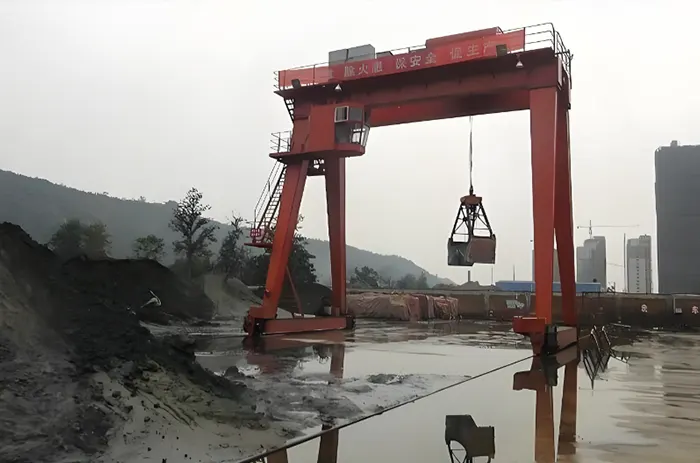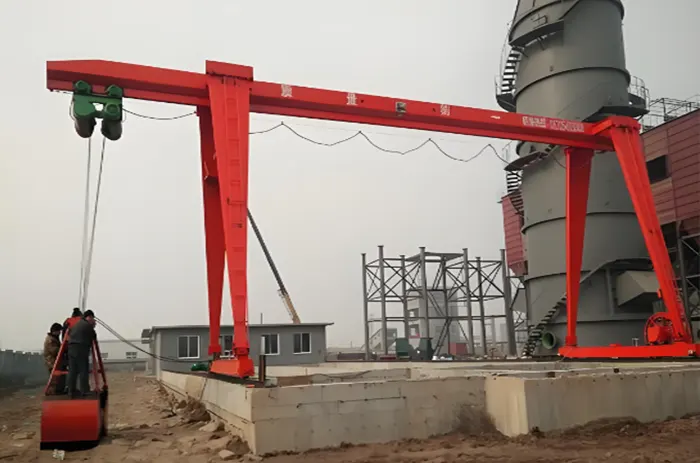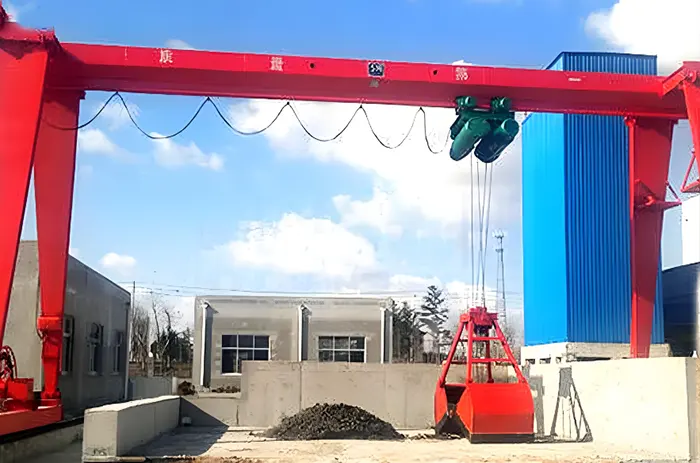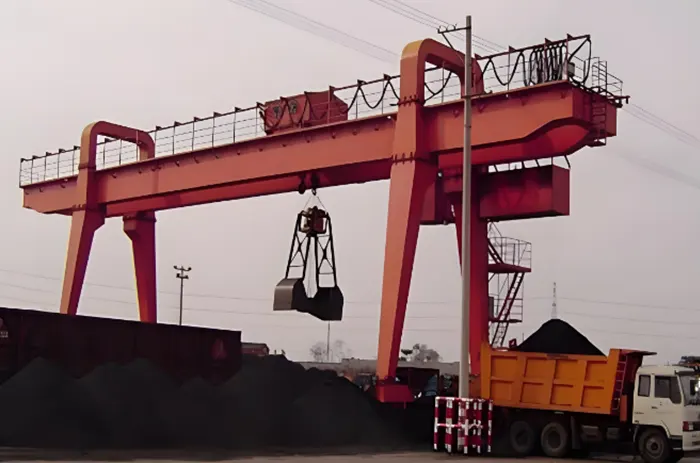Grab Bucket Gantry Crane: Choose Grab Bucket for Gantry Crane?
How to choose the right grab bucket for gantry cranes? Check gantry crane grab bucket types, applications, & key selection factors.Get your custom design!
Overview of Grab Buckets
Grab buckets are essential attachments for gantry cranes, designed to handle various types of materials efficiently. These specialized tools come in different designs, each tailored to specific handling needs. Grab buckets operate by using mechanical or hydraulic systems to open and close their jaws, allowing them to pick up, transport, and release materials. They are widely used in various industries, including construction, port operations, recycling, and steel production.
Importance of Selecting the Right Grab Bucket for Gantry Cranes
Choosing the right grab bucket for your gantry crane is crucial for optimizing performance and ensuring safe operations. The correct bucket type and size ensure efficient material handling, which directly impacts productivity and operational costs. Using a bucket that is not suited to the material type or the crane's capacity can lead to decreased efficiency, increased wear and tear, and potential safety hazards.
Selecting the appropriate grab bucket involves considering factors such as the material characteristics, load capacity, and compatibility with the crane. By aligning the grab bucket’s design with the specific needs of your operation, you can enhance the handling process, reduce maintenance issues, and ensure a safer working environment. This choice ultimately contributes to smoother operations and improved overall performance of your gantry crane system.
Types of Grab Buckets
Clamshell Buckets
- Design and Operation:Clamshell buckets feature two halves that open and close like a clamshell, allowing them to scoop, grip, and release materials efficiently. They are operated using either a cable or hydraulic system, which provides precise control over the bucket's movements. The bucket's design is ideal for handling bulk materials with varying sizes and shapes, making it versatile in different settings.
- Typical Applications:Clamshell buckets are commonly used in construction sites for moving soil, gravel, and debris. They are also effective in port operations for handling bulk commodities like coal and grains. Their ability to handle a range of material sizes and types makes them a popular choice for general-purpose material handling tasks.
Orange Peel Buckets
- Design and Operation:Orange peel buckets have multiple, independently operated claws that resemble the peel of an orange. These claws can open and close to grasp materials securely. Typically operated by hydraulic systems, they offer excellent gripping power and are ideal for handling irregularly shaped or bulky materials.
- Typical Applications:Orange peel buckets are widely used in the steel and scrap metal industries, where they are employed to handle large, heavy scrap metal pieces. They are also used in recycling facilities to manage and sort various recyclable materials, including metal, plastic, and paper.
Hydraulic Grab Buckets
- Design and Operation:Hydraulic grab buckets use hydraulic cylinders to operate their jaws, providing strong gripping force and precise control. This design allows for efficient handling of both fine and coarse materials. The hydraulic system offers smooth operation and can be adjusted for different handling requirements.
- Typical Applications:Hydraulic grab buckets are ideal for applications requiring high efficiency and power, such as in port operations for bulk material handling and in construction for moving heavy and dense materials. They are also suitable for handling materials in challenging environments where precise control is essential.
Specialty Grab Buckets
- Custom Designs:Specialty grab buckets are custom-designed to meet specific operational needs and material types. These buckets can be tailored with unique features such as reinforced jaws or specialized gripping mechanisms to handle particular materials or to operate in specialized environments.
- Niche Applications:Specialty grab buckets are used in niche applications such as handling hazardous materials, working in extreme temperatures, or managing highly specific industrial processes. Examples include buckets designed for underwater operations, environments with high levels of dust or debris, or for handling oversized materials in specialized manufacturing processes.

Factors to Consider When Choosing a Grab Bucket
Material Characteristics
Types of Materials Handled
When choosing a grab bucket, it's crucial to consider the types of materials it will handle. Grab buckets are tailored for various material types, including:
- Bulk Materials: For materials like coal and grains, which are usually handled in large volumes. Clamshell buckets are commonly used for their ability to scoop and lift bulk items efficiently.
- Granular Materials: For materials such as sand and gravel. These materials require buckets with fine controls and the ability to handle smaller particles without spillage.
- Large Objects: For items like construction debris and scrap metal. Heavy-duty buckets with strong, wide jaws are essential to manage and transport large and heavy objects safely.
Choosing the right bucket type ensures effective material handling and optimal operational efficiency.
Material Density and Size
- Material Density:The density of the material affects the bucket’s design and construction. Dense materials, such as steel billets, require buckets with reinforced structures and high gripping strength to handle the weight without compromising safety. Hydraulic grab buckets are often preferred for such tasks due to their robust construction and powerful grip.
- Material Size:The size of the material influences bucket design. For larger objects, such as construction debris or oversized scrap metal, buckets with wider opening jaws and specialized designs are necessary to accommodate and handle these materials effectively. Conversely, smaller materials, like grains or sand, can be managed with buckets that have more flexible designs and finer controls.
Selecting a bucket that matches both the density and size of the material ensures efficient and safe handling, reducing wear and tear on equipment and improving overall operational performance.
Load Capacity
Matching Bucket Capacity with Crane Capacity
When selecting a grab bucket, it’s crucial to ensure that its capacity is compatible with the gantry crane's load capacity. This means the bucket should be rated to handle the maximum load that the crane can lift. Using a bucket with a capacity that exceeds the crane’s limits can lead to overloading, while a bucket with insufficient capacity can result in inefficient material handling. It’s important to verify both the bucket and crane specifications to ensure they are compatible, thus avoiding operational inefficiencies and potential safety hazards.
Ensuring Safe Load Handling
Safety is a critical factor when handling heavy loads with a grab bucket. Choose a bucket designed with features that support safe load handling, such as:
- Reinforced Structures: Buckets should have strong, durable materials and construction to handle the weight and stress of heavy loads.
- Secure Gripping Mechanisms: Effective gripping mechanisms prevent materials from slipping or falling during transport.
- Safety Certifications: Ensure the bucket meets industry standards and safety certifications to guarantee it’s built for reliable performance.
By selecting a grab bucket that prioritizes safety and adheres to industry standards, you minimize risks during operation and enhance overall safety for personnel and equipment.
Bucket Size and Design
Selecting the Right Size for Efficiency
Choosing the right size for a grab bucket is essential for optimizing material handling efficiency. The bucket size should align with both the volume of material you need to handle and the dimensions of the gantry crane. An appropriately sized bucket ensures:
- Efficient Handling: A correctly sized bucket minimizes the number of cycles needed to handle a given amount of material, speeding up the process and reducing cycle times.
- Operational Ease: A bucket that's too small will require more frequent emptying and refilling, while a bucket that's too large may be cumbersome and difficult to maneuver, potentially causing operational challenges and inefficiencies.
Design Features for Specific Tasks
Different applications may require specialized design features in a grab bucket. Consider the following aspects based on the tasks at hand:
- Jaw Width and Shape: Buckets designed for bulk materials, such as coal or grains, often have wider jaws to accommodate larger volumes. In contrast, buckets for scrap metal may have reinforced, narrower jaws to handle irregularly shaped pieces.
- Bucket Shape: The shape of the bucket can affect its ability to scoop, hold, and release materials. For instance, clamshell buckets have a shape ideal for bulk materials, while specialized shapes might be necessary for handling large, irregularly shaped objects.
- Operational Controls: Features such as hydraulic controls or manual mechanisms should be suited to the specific tasks. Advanced control systems may be needed for precise handling of delicate or valuable materials.
Selecting a bucket with the right size and design features ensures efficient material handling, tailored to your specific operational needs.
Compatibility with Gantry Cranes
Ensuring Proper Fit and Functionality
When selecting a grab bucket, it's essential to ensure that it is compatible with your gantry crane’s specifications. Key considerations include:
- Secure Fit: The bucket should fit securely onto the crane’s hook or attachment system. It must align properly with the crane’s load-bearing components to prevent slippage or misalignment during operation.
- Operational Mechanism: Verify that the bucket's operational mechanism integrates seamlessly with the crane's controls. This ensures that the bucket can be effectively operated without causing disruptions or malfunctions.
Proper fit and functionality are crucial for smooth operation, preventing equipment malfunctions and ensuring reliable performance.
Integration with Crane Systems
The grab bucket should integrate well with the crane’s hydraulic or mechanical systems. This involves:
- Compatibility with Control Systems: Ensure that the bucket is compatible with the crane’s control systems. This includes checking whether the bucket’s hydraulic or mechanical controls can be synchronized with the crane’s lifting and movement controls.
- Synchronization: The bucket’s operation should be synchronized with the crane’s lifting and movement capabilities. Proper integration ensures that the bucket functions efficiently with the crane, enhancing overall performance and minimizing wear and tear.
Effective integration with the crane’s systems ensures smooth, efficient operation and helps extend the lifespan of both the crane and the grab bucket.
Applications of Different Grab Buckets
Construction Sites
Handling Materials like Concrete and Debris
On construction sites, grab buckets are crucial for efficiently managing materials such as concrete blocks, debris, and construction waste. Clamshell buckets are often used for their versatility in handling various types of debris and bulk materials. Their ability to scoop, lift, and transport large quantities helps maintain the flow of materials and supports timely project completion. Additionally, hydraulic grab buckets are effective in managing dense and heavy construction materials.
On construction sites, grab buckets play a vital role in managing and transporting materials efficiently. Here's how they are used:
- Concrete Blocks: Grab buckets, particularly clamshell types, are designed to handle and move heavy and bulky concrete blocks. Their robust design allows for the effective lifting and positioning of these materials, which is essential for constructing foundations, walls, and other structural elements.
- Debris and Construction Waste: During construction and demolition, a large volume of debris and waste is generated. Grab buckets are well-suited for collecting and transporting debris like wood, metal scraps, and other waste materials. Their versatile gripping capabilities make them ideal for managing irregularly shaped and varied debris.
- Bulk Materials: For tasks that involve moving bulk materials, such as sand, gravel, and soil, grab buckets offer the flexibility and capacity needed to handle large quantities efficiently. Their design facilitates quick loading and unloading, helping to keep construction projects on schedule.
- Hydraulic Grab Buckets: These are especially effective for handling dense and heavy materials like large rocks or demolition rubble. Their hydraulic systems provide powerful gripping and lifting capabilities, ensuring that even the most challenging materials can be managed safely and efficiently.
Overall, grab buckets help streamline material handling on construction sites, supporting the smooth flow of materials and contributing to timely project completion.
Port and Harbor Operations
Managing Bulk Commodities such as Coal and Grains
In ports and harbors, grab buckets play a vital role in loading and unloading bulk commodities like coal, grains, and minerals. Orange peel buckets are commonly used in these environments due to their robust design and ability to handle large and irregularly shaped materials. They provide efficient handling, minimizing spillage and optimizing throughput. Clamshell buckets are also utilized for their adaptability to different types of bulk materials.
In ports and harbors, grab buckets are essential for the efficient handling of bulk commodities. Here’s how they are utilized:
- Coal and Grains: For loading and unloading bulk materials like coal and grains, orange peel buckets are commonly employed. Their robust design, featuring multiple jaws, allows them to handle large, irregularly shaped materials with ease. This design helps to minimize spillage and optimize the throughput of materials.
- Bulk Commodities Handling: Orange peel buckets excel in environments where large volumes of bulk commodities need to be moved quickly and efficiently. Their ability to grip and release materials securely ensures a smooth flow of operations and reduces the risk of material loss.
- Clamshell Buckets: These are also used in ports and harbors due to their versatility. They can handle a range of materials, including various types of bulk goods. The clamshell design, with its adjustable jaws, allows for precise control and effective management of different material types.
In both cases, the choice of grab bucket—whether orange peel or clamshell—depends on the specific characteristics of the materials being handled. The appropriate bucket enhances operational efficiency, reduces material spillage, and supports effective throughput in busy port and harbor environments.
Recycling Facilities
Sorting and Transporting Recyclables
Recycling facilities benefit from grab buckets in sorting and transporting a wide range of recyclable materials, including paper, plastic, and metal. Orange peel buckets are particularly effective for managing mixed materials and handling large volumes of recyclables. Specialty grab buckets with custom designs can also be employed for specific recycling tasks, ensuring efficient sorting and processing of various waste streams.
In recycling facilities, grab buckets are instrumental in efficiently sorting and transporting a variety of recyclable materials. Here’s how they are applied:
- Mixed Materials Handling: Orange peel buckets are especially effective in recycling facilities for managing mixed recyclable materials. Their robust design, with multiple gripping jaws, enables them to handle large volumes of varied materials, including paper, plastic, and metal. This makes them ideal for sorting and transferring recyclables in bulk.
- Specialty Grab Buckets: For specialized recycling tasks, custom-designed grab buckets are used. These buckets can be tailored to handle specific types of materials or to fit particular operational requirements. Custom features might include specialized jaw shapes or enhanced gripping mechanisms to handle unique waste streams efficiently.
- Efficient Sorting and Processing: Grab buckets facilitate the efficient sorting and processing of recyclables. By quickly and effectively moving materials from one area to another, they support streamlined recycling processes and contribute to the overall efficiency of waste management operations.
Overall, the right grab bucket enhances the ability to manage and process diverse recyclable materials, improving sorting accuracy and operational efficiency in recycling facilities.
Steel and Metal Industries
Moving Steel Billets and Scrap Metal
In the steel and metal industries, grab buckets are essential for moving heavy steel billets, scrap metal, and other large components. Hydraulic grab buckets are often used due to their strong gripping power and precision, which are necessary for handling heavy and often hot materials. These buckets help streamline operations by facilitating the efficient transfer of materials between different stages of processing and storage.
In the steel and metal industries, grab buckets are crucial for handling heavy and large materials. Here’s how they are utilized:
- Steel Billets: Hydraulic grab buckets are commonly used to move steel billets due to their robust construction and powerful gripping capabilities. These buckets can handle the high temperatures and substantial weights associated with steel billets, ensuring safe and efficient transfer between processing stages and storage areas.
- Scrap Metal: For managing scrap metal, grab buckets with strong, durable designs are essential. Hydraulic models provide the necessary strength and precision for handling various types of scrap, including large and irregularly shaped pieces. Their ability to grip securely helps in sorting and transferring scrap metal efficiently.
- Efficient Material Transfer: Grab buckets facilitate the smooth movement of materials throughout the steel and metal processing facilities. By enabling quick and precise handling, they support continuous operation and enhance overall productivity.
Overall, hydraulic grab buckets are vital in the steel and metal industries for their ability to manage heavy and often hot materials, streamlining processes and improving operational efficiency.
Benefits of Choosing the Right Grab Bucket
Operational Efficiency
Enhancing Material Handling Efficiency
Selecting the right grab bucket significantly improves operational efficiency. The correct bucket type and size ensure that materials are handled quickly and accurately, reducing the time spent on each load cycle. Efficient material handling enhances productivity, allowing for higher throughput and better utilization of the gantry crane. For example, using a clamshell bucket suited for bulk materials can speed up loading and unloading processes, while a hydraulic grab bucket ensures precise control for handling dense or irregularly shaped materials.
Safety and Reliability
Reducing Operational Risks and Ensuring Safety
Choosing an appropriate grab bucket is crucial for maintaining safety and reliability in operations. A well-designed bucket reduces the risk of operational hazards, such as spillage or equipment failure. For instance, buckets with secure gripping mechanisms and reinforced structures help prevent accidental drops or material slippage. Additionally, ensuring that the bucket is compatible with the crane’s specifications and operational systems contributes to a safer working environment and reduces the likelihood of accidents or equipment malfunctions.
Cost-Effectiveness
Optimizing Performance and Reducing Maintenance Costs
The right grab bucket can lead to significant cost savings over time. By selecting a bucket that matches the specific requirements of your operation, you can optimize performance and minimize unnecessary wear and tear on both the bucket and the crane. This optimization results in lower maintenance costs and fewer repairs. For example, choosing a bucket with durable materials and appropriate design features reduces the frequency of replacements and extends the lifespan of the equipment. Furthermore, efficient material handling can lead to reduced labor costs and increased operational efficiency, contributing to overall cost savings.
Tips for Selecting the Best Grab Bucket
Consulting with Experts
Engaging with Suppliers and Manufacturers
To ensure you select the most suitable grab bucket, engage with suppliers and manufacturers who specialize in material handling equipment. Consulting with these experts can provide valuable insights into the best options based on your specific needs. They can offer recommendations based on their experience and help you understand how different buckets will perform in your operational environment. Additionally, suppliers can provide information on the latest technologies and innovations that may benefit your operations.
Evaluating Product Specifications
Comparing Technical Details and Features
Thoroughly evaluate the technical specifications and features of various grab buckets to make an informed decision. Compare details such as load capacity, jaw design, material strength, and operational mechanisms. Understanding these specifications will help you select a bucket that meets your handling requirements and integrates well with your existing gantry crane systems. Pay attention to details like bucket size, gripping power, and compatibility with different materials to ensure optimal performance.
Testing and Validation
Conducting Trials to Ensure Performance
Before finalizing your choice, conduct trials or tests of the grab bucket to validate its performance in your operational setting. Testing allows you to assess how well the bucket handles materials, interacts with your crane, and performs under actual working conditions. This hands-on approach helps identify any potential issues and ensures the bucket meets your performance expectations. If possible, observe the bucket in action at a similar facility or request a demonstration from the supplier to confirm its suitability for your needs.
Conclusion
Selecting the right grab bucket is crucial for optimizing the performance and safety of your gantry crane operations. We discussed various types of grab buckets, including clamshell, orange peel, hydraulic, and specialty designs, each tailored to specific material handling needs. Key factors to consider include material characteristics, load capacity, bucket size and design, and compatibility with your crane system. By evaluating these aspects carefully, you can enhance operational efficiency, ensure safety, and achieve cost-effectiveness.
To make an informed decision, consult with industry experts and suppliers to gain insights into the best options for your specific requirements. Evaluate detailed product specifications and features to match the grab bucket with your handling needs. Finally, conduct trials to validate the bucket’s performance in your operational environment. By following these steps, you will select a grab bucket that optimizes material handling, enhances safety, and provides long-term value for your operations.




